Vallisneria Overview
Looking to add some aquatic magic to your aquascape? Look no further than Vallisneria! Known lovingly as “val,” “eelgrass,” or “tape grass,” this stunning freshwater plant hails from the tropics and subtropics, flaunting a variety of shapes, sizes, and colors. Its elongated, slender leaves cluster together, forming an underwater cascade of green that’s nothing short of mesmerizing.
Vallisneria isn’t just a pretty face, though. It’s a hard-working hero for any tank, offering cozy shelter to your smaller fish and invertebrates while actively improving your water quality. Imagine that! Your aquatic vegetation tirelessly working to oxygenate and purify your tank.
With the right conditions, it’ll fill your tank in no time, creating an enchanting backdrop or vibrant centerpiece to your aquascape.
Table of Contents
Description and Identification of Vallisneria
Vallisneria, also known as “val,” “eelgrass,” or “tape grass,” is recognizable by its long, slender leaves growing from a central cluster.
Depending on the variety, leaves range from bright lime to deep green, sometimes featuring reddish tints or leopard spots. The plant’s vertical, grass-like structure creates a striking underwater display, while its rapid growth via runners allows it to spread efficiently in an aquatic environment.
Aesthetically pleasing and beneficial, Vallisneria serves as a shelter for smaller aquatic creatures and contributes to a healthy aquarium ecosystem, making it a top choice among aquarists. 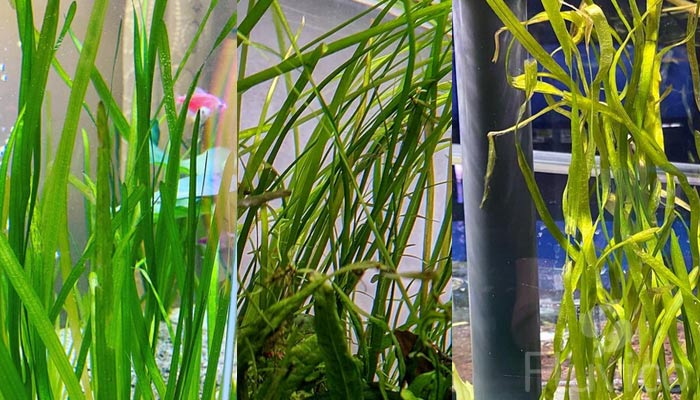
Most Popular Varieties of Vallisneria
Vallisneria americana (gigantea)
Renowned for its grand, ribbon-like leaves, the American Eelgrass, scientifically known as Vallisneria americana, is a top choice for aquascaping enthusiasts. Its foliage, which can stretch up to 6 feet, adds a lush, green depth to any aquarium, mimicking the look of an underwater grassland.
This North American native is also commonly called Vallisneria gigantea, Water Celery, Eelgrass, or Tapegrass. Interestingly, it shares striking similarities with the Asian variant, Vallisneria asiatica.
Thriving under low light and CO2 conditions, American Eelgrass grows swiftly via runners, making it an excellent beginner-friendly plant. More than just an aesthetic booster, it also provides a vital habitat for a variety of aquatic life forms.
Vallisneria nana
Vallisneria nana, commonly known as Narrowleaf Vallisneria or Vals nana, is a much-loved addition to the realm of aquarium plants. Also with its slim, ribbon-like leaves, this aquatic flora brings a unique charm and elegance to your tank, enhancing its natural beauty.
Originally from Australia, Vals nana is a smaller cousin in the Vallisneria family, making it a perfect fit for various aquarium sizes. Despite its delicate appearance, this plant is robust and low-maintenance, making aquarium care a breeze, even for beginners.
In addition to its aesthetic allure, Vallisneria nana serves as a safe hideout for your aquatic fauna, contributing to a harmonious underwater ecosystem.
Corkscrew Vallisneria
The Corkscrew Vallisneria, known scientifically as Vallisneria asiatica, is a decorative aquatic plant adored by aquarists. With its unique spiraled leaves, this plant adds a captivating twist to any aquarium, especially shrimp tanks, where it provides excellent cover.
Unlike most aquatic plants, growing Corkscrew Vallisneria isn’t a complex task. Even novice plant keepers can maintain its health thanks to its hardiness and low light requirements. This easy plant not only enhances your tank’s aesthetic appeal but also contributes to the overall health of your aquatic ecosystem.
Add some Corkscrew Vallisneria to your aquarium and let it work its spiral magic!
Vallisneria spiralis
Vallisneria spiralis, popularly known as Eelweed, is a favored aquarium plant among freshwater tank enthusiasts. Its long, slender, and spiraled leaves create an attractive, flowing underwater spectacle, perfect for any planted freshwater tank.
Easy to maintain, Eelweed is highly adaptable, flourishing in various light and water conditions, making it a go-to choice for both novice and expert aquarists. Moreover, Vallisneria spiralis enhances the health of the aquatic ecosystem, providing shelter for small fish and invertebrates while helping to maintain water quality.
Add some Eelweed to your aquarium, and watch your freshwater habitat come alive with its unique charm! 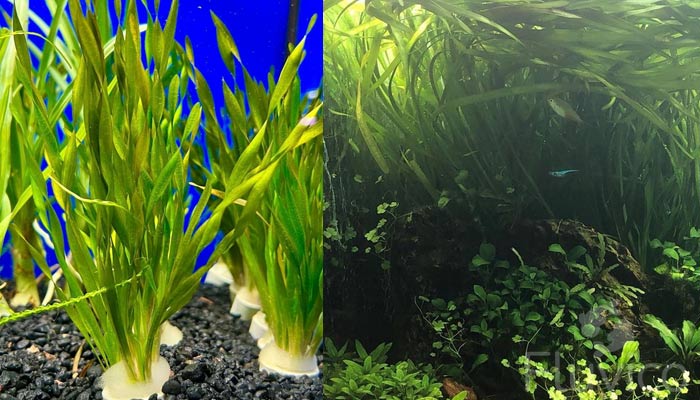
Origin and Habitat of Vallisneria
Vallisneria is a genus of freshwater aquatic plants that is widely distributed in tropical and subtropical regions across the globe. It’s found in a diverse range of habitats, from shallow ponds and streams to large lakes and rivers.
The plant is even capable of thriving in brackish waters, which demonstrates its high adaptability. The genus Vallisneria was first described by the Swedish botanist Carl Linnaeus in the 18th century, and it has since been discovered in various parts of the world.
Different species within the genus have different native ranges. For example, Vallisneria americana, also known as American eelgrass, is native to North America, while Vallisneria spiralis originates from Europe and Asia. Regardless of their specific origin, all Vallisneria species share a preference for submerged conditions, stable water parameters, and a soft substrate in which to anchor their roots.
The plant’s ability to reproduce through runners allows it to spread effectively in these environments, often forming extensive underwater meadows. These meadows not only enhance the biodiversity of their habitat but also contribute to the overall health and stability of the aquatic ecosystem.
Benefits and Uses of Vallisneria
Vallisneria, commonly known as tape grass or eelgrass, is an aquatic plant that holds several benefits and uses in an aquarium setting. Here are a few of them:
- Aquascaping: With its tall, ribbon-like leaves, Vallisneria creates a stunning underwater landscape. It’s perfect for filling in the background of an aquarium and creating a “curtain” effect.
- Shelter: Vallisneria provides excellent cover for small aquatic animals, such as shrimp and small fish. This makes the aquarium environment more comfortable and secure for these creatures.
- Oxygenation: Like all plants, Vallisneria produces oxygen during photosynthesis, which can help to oxygenate the aquarium water.
- Water Purification: Vallisneria can absorb certain harmful substances, such as nitrate, from the water. This can contribute to maintaining the water quality in the tank.
- Algae Control: By absorbing nutrients from the water, Vallisneria can help limit the growth of algae, as it competes with algae for the same resources.
- Foraging Site: Vallisneria leaves can host small particles of food and microorganisms, making them a great foraging site for shrimp and some fish.
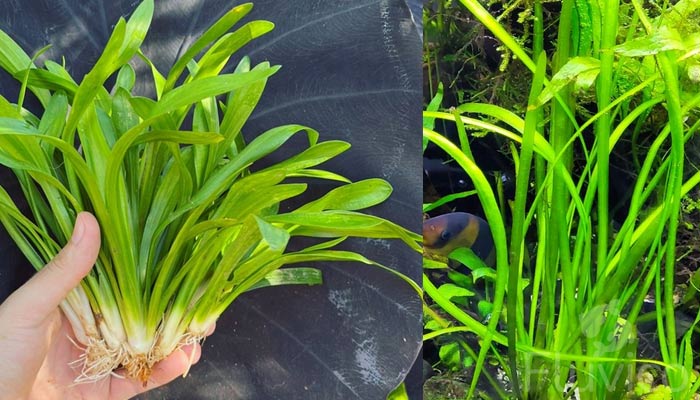
Understanding the Difference between Sagittaria and Vallisneria
When choosing aquatic plants for your aquarium, two names that often pop up are Sagittaria and Vallisneria. Both are popular and beginner-friendly options, but they do come with distinct characteristics.
Let’s explore some key differences in terms of appearance, growth habits, care requirements, and aquascaping uses in the following bullet points:
Sagittaria vs. Vallisneria:
- Appearance:
- Vallisneria: Long, slender, ribbon-like leaves in dense clusters.
- Sagittaria: Broader, shorter, arrowhead-shaped leaves.
- Growth:
- Vallisneria: Spreads via horizontal runners.
- Sagittaria: Spreads via runners and sometimes bulb-like tubers.
- Care:
- Vallisneria: Prefers slightly harder water, wider pH range, requires less light.
- Sagittaria: Can grow above the water surface in certain conditions.
- Aquascape Use:
- Vallisneria: Often used as a background plant, resembling underwater seagrass.
- Sagittaria: Depending on the species, used in the foreground or midground. Dwarf varieties can form grass-like carpets.
Both plants are generally easy to care for and adaptable to a range of aquarium conditions.
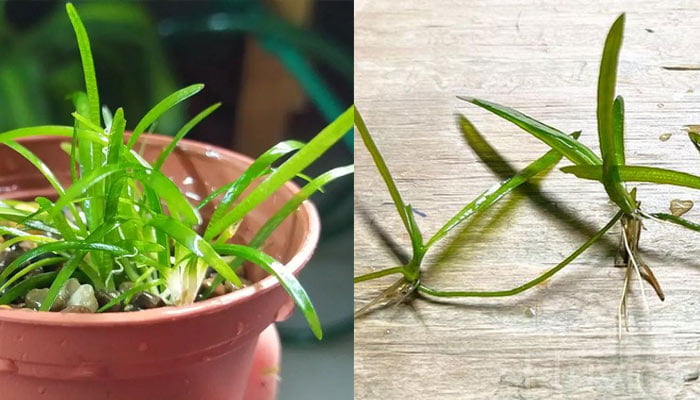
How to Grow Vallisneria in Your Aquarium
Setting up Your Aquarium Tank
- Choose the Right Tank: Vallisneria species can grow quite tall, so choose a tank that is deep enough to accommodate their growth. A 20-gallon tank is a good starting point.
- Clean the Tank: Clean your tank thoroughly with warm water. Avoid using soap or chemicals that may harm your plants and fish.
- Install Equipment: Vallisneria requires moderate lighting, so make sure your tank is equipped with suitable aquarium lights. Install a heater to maintain a temperature between 20-28°C (68-82°F), which is ideal for Vallisneria.
- Add Substrate: Vallisneria plants anchor their roots in the substrate. Opt for a nutrient-rich substrate to promote healthy growth.
- Arrange Decorations and Plants: Before filling the tank with water, place your Vallisneria plants in the substrate. Also, add other decorations such as rocks and driftwood.
- Fill the Tank: Fill the tank with water. Make sure the water condition is suitable for Vallisneria—soft to moderately hard water with a neutral to slightly alkaline pH is ideal. The optimal pH range is typically between 6.5-8.5
- Cycle the Tank: Let the tank cycle to build up beneficial bacteria. This process might take a few weeks but is essential for a healthy aquatic environment.
- Introduce Other Aquatic Life: After the tank has cycled, you can introduce fish and other aquatic creatures. Choose species that are compatible with Vallisneria, such as calm fish, shrimp, and snails.
- Regular Maintenance: Perform regular water changes and check the water parameters to ensure the conditions remain suitable for Vallisneria. Trimming might be necessary if the plants grow too tall.
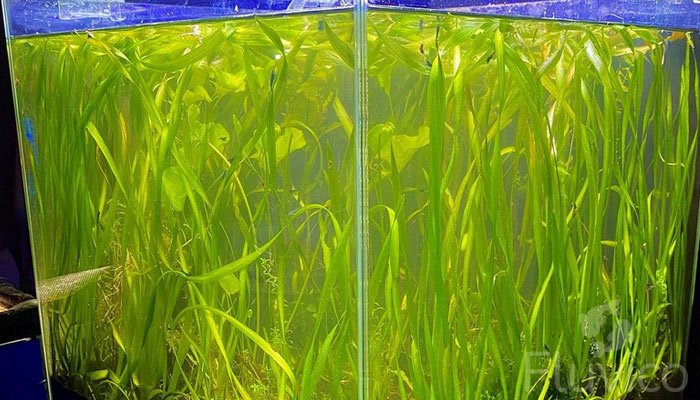
Why to Quarantine Vallisneria?
Quarantining Vallisneria, like any other aquatic plant, is an important step before introducing it into your main aquarium. Here’s why and how you should do it:
- Disease Prevention: The quarantine process helps prevent the introduction of diseases or parasites that could harm your fish or other aquatic life.
- Pest Control: Vallisneria can sometimes come with unwanted pests like snails or algae. Quarantine can help manage these issues before they enter your main tank.
- Acclimatization: Quarantine provides a stress-free environment for the plant to adjust to new water conditions, which can reduce the risk of plant melting.
Filtration and Flow
Keeping your aquarium’s water clean and maintaining the right flow is essential for the health of your Vallisneria and other aquatic life. Here’s a brief guide:
Filtration:
- Keeps the water clean by removing waste, excess food, and toxins.
- Types: mechanical (removes solids), chemical (removes dissolved substances), and biological (breaks down harmful chemicals).
- Choose a filter based on your tank size and the needs of your aquatic life.
Flow:
- Distributes heat and oxygen evenly in the tank.
- Carries nutrients to plants and waste to the filter.
- Vallisneria can handle various flow levels, but moderate is generally best.
- Adjust your filter or add a pump for optimal flow.
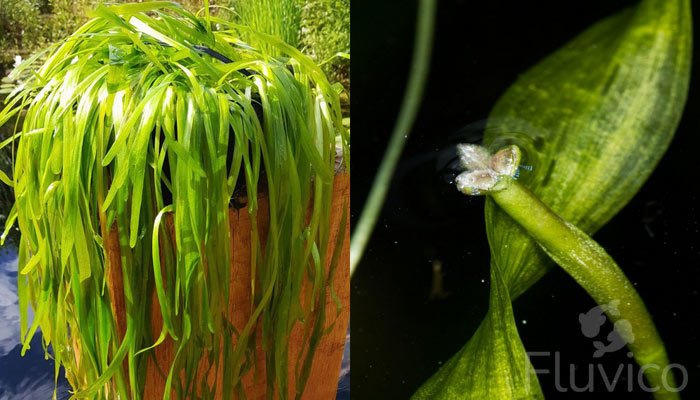
CO2 Injection and Fertilization of Vallisneria
Vallisneria, like all plants, requires carbon dioxide (CO2) and nutrients for photosynthesis and growth. However, Vallisneria is quite adaptable and can usually get by with the CO2 and nutrients naturally present in your aquarium. Here are some points to consider:
CO2 Injection:
- Vallisneria can typically thrive with the amount of CO2 that fish produce naturally.
- However, in densely planted tanks or for faster growth, you might consider a CO2 injection system. This can provide a more consistent and higher level of CO2.
- Be careful when adjusting CO2 levels, as too much can harm your fish.
Fertilization:
- Vallisneria draws nutrients from the water through its leaves and from the substrate through its roots.
- You can use a comprehensive liquid fertilizer for the water column.
- For nutrients in the substrate, root tabs placed near the plant’s roots can be beneficial.
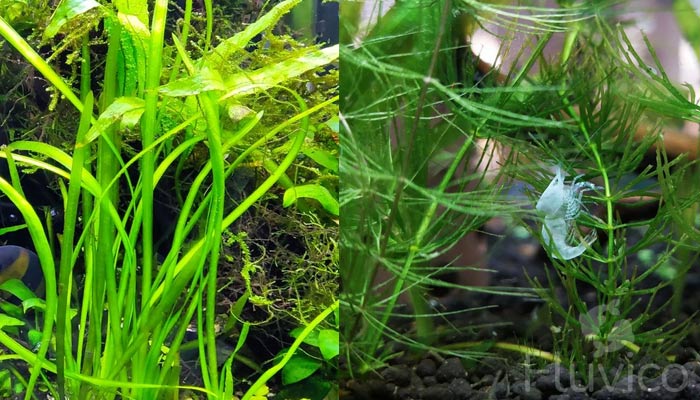
Care and Maintenance of Vallisneria
Trimming Vallisneria
- Identify what needs to be trimmed: Vallisneria leaves can grow quite long and sometimes outgrow your tank. Look for leaves that are too long, discolored, or damaged as these are the ones that need to be trimmed.
- Use sharp, clean scissors: Sharp scissors provide a clean cut and reduce damage to the plant. Be sure to disinfect the scissors before using them to prevent the spread of any potential disease or pests.
- Trim leaves individually: Hold the leaf you are going to trim between your fingers, then cut it at an angle. Angled cuts look more natural and are less likely to damage the plant than straight cuts.
- Don’t overdo it: Remove only about one-third of the plant at a time. Over-trimming can stress the plant and stunt its growth.
- Regularly monitor the plant’s health: If you notice more leaves becoming discolored or damaged, it may indicate a problem with water quality, lighting, or nutrients. Adjust these factors as needed.
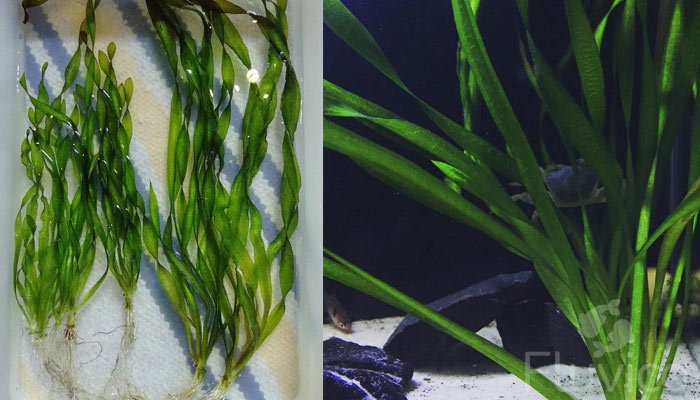
How to Plant and Propagate Vallisneria
Planting and propagating Vallisneria is relatively straightforward, and here’s how you can do it:
- Prepare the plant: Rinse the Vallisneria under running water to remove any debris or loose leaves.
- Plant in substrate: Dig a small hole in your tank’s substrate, place the Vallisneria’s roots in the hole, and gently cover them with substrate. Be careful not to bury the crown (where the leaves start growing), as this can cause the plant to rot.
- Let the runners grow: When your Vallisneria is healthy and well-established, it will naturally start sending out runners.
- Wait for plantlets: In time, you’ll notice plantlets starting to form along the runners. These plantlets will develop their own root systems and can be left to grow where they are.
- Optional – separate plantlets: If you want to move a plantlet, wait until it has grown roots that are at least an inch long. Then, you can carefully cut the runner on both sides of the plantlet and replant it in a new location.
Common Problems Associated with Vallisneria
Even though Vallisneria is relatively hardy and adaptable, it can still encounter certain issues.
- Melting: This is a common issue for many aquatic plants when they’re introduced to a new environment. The plant’s leaves may become translucent and start to disintegrate. This is often temporary as the plant acclimates to its new surroundings.
- Chlorosis: This is the yellowing of the leaves, which often suggests a deficiency in essential nutrients, particularly iron.
- Algae growth: Vallisneria can become a host for algae, especially when nutrients in the water are imbalanced or when the lighting is too intense.
- Stunted growth: This often results from inadequate lighting, incorrect water parameters, or nutrient deficiencies.
- Rotting: Overly deep planting or damage to the crown of the plant can lead to rotting. The plant should be planted so that the crown is at the substrate surface.
- Snail infestations: Vallisneria can sometimes carry pest snails or their eggs. Proper quarantine and inspection before introduction to the tank can help prevent this issue.

Vallisneria and Tankmates
Vallisneria is generally a very community-friendly plant that can coexist well with a wide variety of tank mates. Here are some ideal tank mates for Vallisneria:
- Peaceful Community Fish: Small to medium-sized peaceful fish like tetras, rasboras, and guppies are suitable tankmates. They don’t pose a threat to the plant, and they also enjoy the cover that Vallisneria provides.
- Bottom Dwellers: Bottom-dwelling species such as Corydoras catfish and loaches can also be good companions as they tend to leave plants alone.
- Shrimps and Snails: Aquatic invertebrates like shrimp and snails can actually benefit Vallisneria by feeding on algae and biofilm that might grow on the plant. Cherry shrimp, ghost shrimp, nerite snails, and mystery snails are all good choices.
Fish Species to Avoid
- Large Cichlids: Many larger cichlid species tend to uproot plants or chew on them. Exceptions can be made for some dwarf cichlids.
- Goldfish: Goldfish are notorious for being rough with plants, often uprooting or eating them.
- Plant-eating Fish: Certain species of fish, like silver dollars and some barbs, are known to eat plants and should not be kept with Vallisneria.
Remember, always do your research before introducing new tank mates to ensure they are compatible with your current setup.
FAQ
Why is my vallisneria dying
Your Vallisneria might be dying due to issues like improper lighting, nutrient deficiencies, unsuitable water parameters, or disease. It’s crucial to examine your tank conditions and the plant’s health to identify the root cause.
Does Vallisneria need lots of light?
How quickly does Vallisneria grow?
Vallisneria typically exhibits a moderate to fast growth rate, depending on the specific conditions in your aquarium. With optimal lighting, temperature, nutrient availability, and CO2 levels, Vallisneria can grow several inches per week. However, growth can be slower in less ideal conditions.
What is the difference between Vallisneria and jungle Vallisneria?
Does vallisneria need co2
More Reading

15 Types of Cryptocoryne: Which is Best For Your Aquarium Setup?

16 Awesome Low Light Aquarium Plants (Mosses, Ferns & Stem Plants)


18 Types of Aquarium Moss: Photos, Care, Propagation & Growth Guide
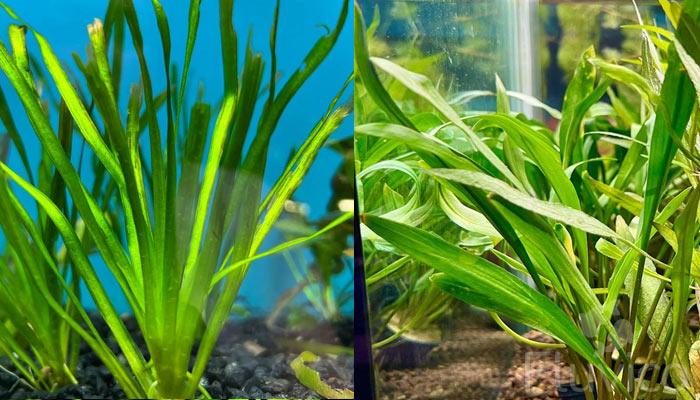
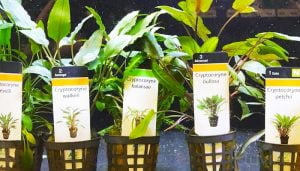
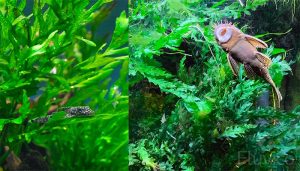
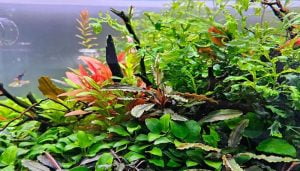

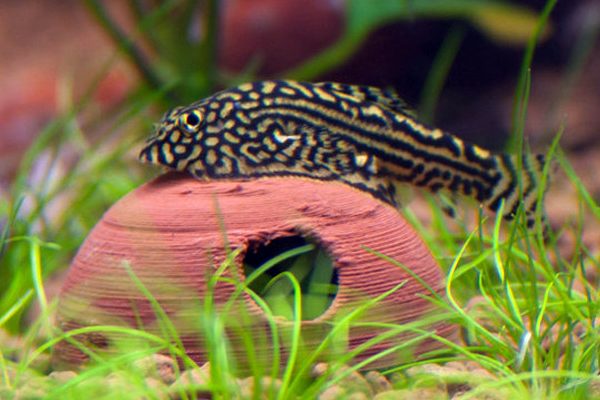
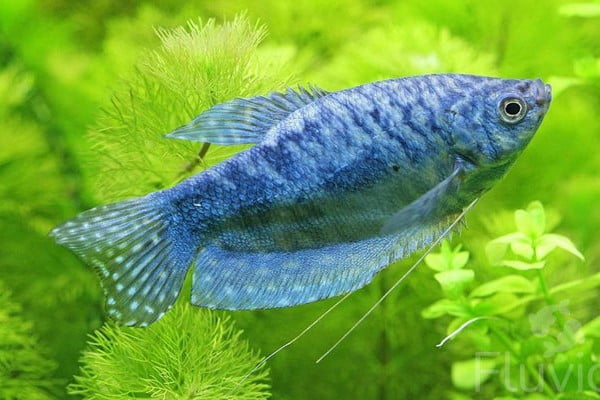
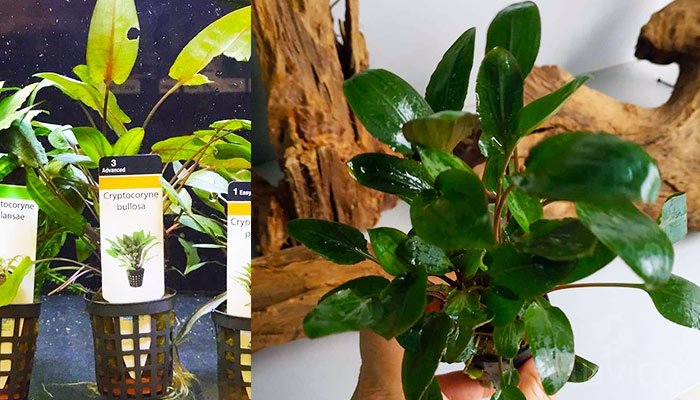
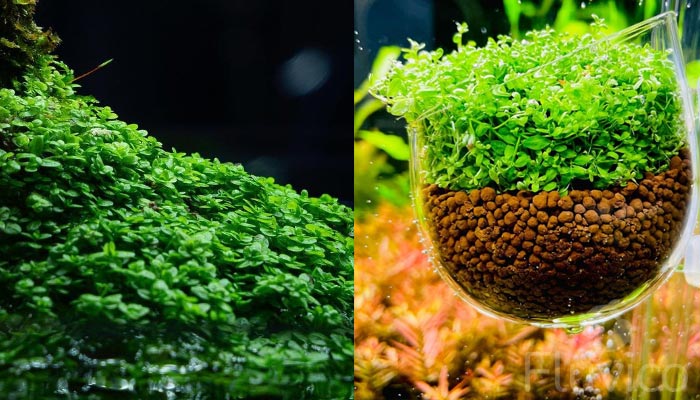
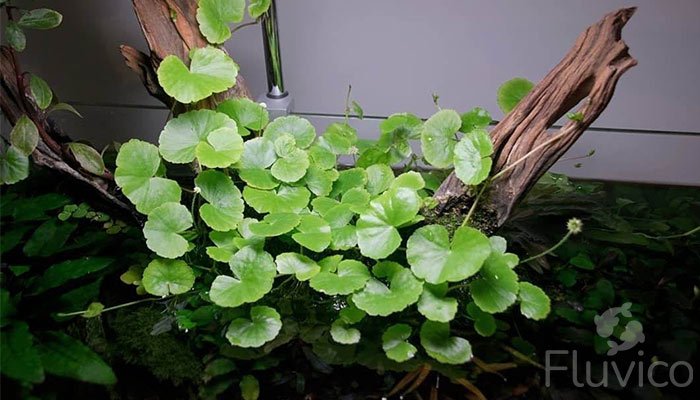
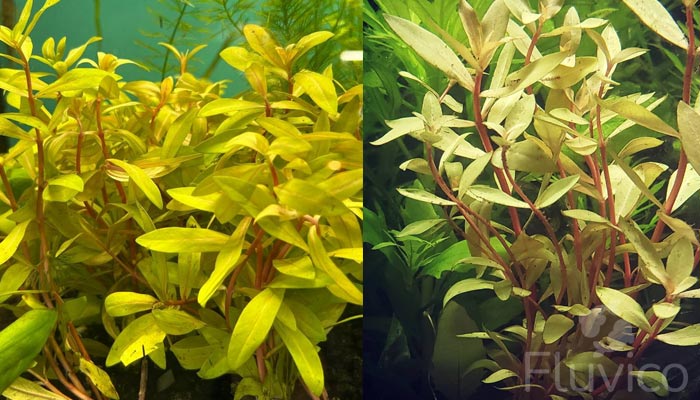
Hope you enjoyed our Vallisneria Care Guide! As always if you have any questions or tips of your own, comment below.
All the best,
Charlie